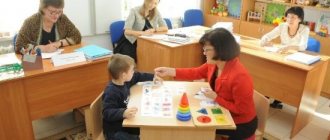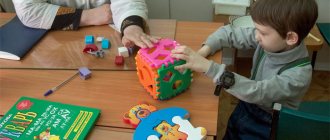Who is a defectologist
A defectologist is a correctional teacher who works with children with developmental disabilities. Despite the fact that the science of defectology developed at the intersection of medicine and pedagogy, this specialist is not a doctor. He is a special education teacher, and his main task is teaching and raising children with disabilities (disabilities).
Workers of this profile can be found not only in kindergartens and schools. They can be found in rehabilitation and social centers and clinics. He can work both with a specific child and with a group.
Defectology includes several branches:
- Oligophrenopedagogy - work with intellectual disabilities (mental retardation, mental retardation);
- Deaf pedagogy - work with hearing problems;
- Typhlopedagogy - work with visual impairments;
- Speech therapy - work with speech disorders.
The work of a defectologist in a kindergarten is very diverse and depends on specific disorders. You will rarely find this specialist in a regular school - he works in specialized schools for children with developmental disabilities. The school usually only has a speech therapist who deals with children with speech disorders.
Another important aspect of the work of a defectologist is the instillation of social and everyday skills. A child with intellectual disability does not adapt well to life, and blind people cannot navigate in space. A correctional teacher is called upon to help cope with this.
Bibliography
1. Aksenova, L.I., Arkhipov, B.A., Belyakova, L.I. Special pedagogy: Academic. A manual for students. higher ped. textbook Establishments [Text] / L.I. Aksyonova, B.A. Arkhipova, L.I. Belyakova et al.: Ed. N.M. Nazarova. – 2nd ed., - M.: Publishing House, 2001.-400 p.
2. Bidenko, V. I. Bologna process: problems, experience, solutions. − M.: Research Center for Problems of Quality of Training of Specialists, 2006. Borytko, N. M. Man as a subject of education: modern approaches // Pedagogical anthropology: conceptual foundations and interdisciplinary context. Materials Int. scientific conf. (Moscow, September 30–October 2, 2002) / Comp. V. G. Bezrogov - M.: Publishing house URAO, 2002. - P. 40−43.
3. Gudonis, V.P. Analysis of the causes of developmental disorders in children and some ways to prevent them. [Test] / V.P. Gavrilov // Defectology. – 2004. No. 4. - With. 16-17.
4. Suntsova, A. S. Theories and technologies of inclusive education: textbook. − Izhevsk: Udmurt University, 2013.
5. Professional standard of a teacher. − Order of the Ministry of Labor and Social Protection of the Russian Federation No. 544n dated October 18, 2013.
6. Prevention, diagnosis and correction of developmental disorders / Ed. Lynskoy M.I., Pokrovskoy Yu.A. – M.: LOGOMAG, 2012. – 284 p.
7. Candidate of Pedagogical Sciences, Associate Professor at Moscow State Pedagogical University, Davidovich, L.R. Comprehensive prevention of developmental disorders in young children [Text] / L.R. Davidovich [Electronic resource]. – Access mode: https://pik100.ucoz.ru/konf/patologia/davidovich.htm
Examples of similar educational works
Psychological adaptation of orphans and children left without parental care...
... children left without parental care, aged 12 to 14 years, and 10 foster families. Work structure. The work ... of a child in an orphanage in most cases leads to disturbances in his development ... as a person with a new type of activity, social role, ...
Technology of post-boarding support for orphans and children left behind...
... and children left without parental care, both in the work practice of the institution’s specialists and in the work practice of specialists ... on the approval of criteria and indicators for assessing the activities of the Institution for working with graduates at a meeting of the Council for ...
Pedagogical conditions for the socialization of orphans and children left without parental...
... activities of orphans and children left without parental care; The theoretical and methodological basis of the study are: the cultural and historical concept of child development and the position on the unity of the laws of development of a normal child and a child...
Social and psychological rehabilitation of children left without parental care...
... children left without parental care are a socially unprotected group, whose members have significant difficulties with socialization and/or mental health, ... mental production (activity) and its results; ... the topic of the work, and ...
Fairytale therapy as methods of psychological assistance to children in situations of parental divorce
...a parent. When a serious breakup occurs and the parents decide to separate, for a child of any age... the future cannot be drawn. It’s better not to talk about adultery… children tend to lag behind in development. How to mitigate negative consequences: children...
What kind of work does he do with children?
Teaches, educates, introduces them to the world around them, and more - this is what a defectologist does with children. This is not the most complete list of activities. They depend on the type of violation. The overall goal is to develop motivation for learning.
At the first stage, the teacher-defectologist conducts an examination. It affects all aspects of development. It is checked how children make contact, how they react, and what their pace of work is. Thinking, understanding of instructions, visual and auditory perception are examined.
Based on the results obtained, the teacher divides the children into groups. Pupils in them have approximately the same level of development. It is not possible to conduct group lessons with some children: autistic people fall into this category; these children are more often assigned to individual lessons due to the specific nature of this developmental disorder.
Classes are conducted in several directions:
- At the first stage, familiarization with the surrounding world is carried out. Ideas about it and its laws are formed. They develop attentiveness and responsibility for their actions.
- The second stage is the development of elementary mathematical concepts. During classes, the defectologist talks about the size, shape of objects and other characteristics.
Much attention is paid to sensorimotor development. Separate work is being carried out on the development of sensations. For this purpose, finger pools are made with various cereals and small toys. It is useful to prepare aromatic food, study vegetables, fruits, berries, touch them, examine them with your fingers. All this helps children develop different sensations.
Children with mental retardation have problems with games. It is difficult for them to contact someone and follow the rules. Therefore, they need the help of a speech pathologist. He competently guides the actions of his students and helps them find a common language with each other.
Consultations for parents are also indispensable. A defectologist can answer all their questions, give advice and help cope with the child’s problems.
Rights
A teacher-defectologist has the right:
3.1. All social guarantees provided for by the legislation of the Russian Federation, including:
- for reduced working hours;
— for additional professional education in the profile of teaching activity at least once every three years;
— for the annual basic extended paid leave, the duration of which is determined by the Government of the Russian Federation;
- for a long vacation for a period of up to one year at least every ten years of continuous teaching work;
— for early assignment of an old-age labor pension;
— for the provision of residential premises out of turn under a social tenancy agreement (if the employee is registered as needing residential premises);
— for the provision of residential premises in a specialized housing stock;
— to provide compensation for expenses for living quarters, heating and lighting [for those living and working in rural settlements, workers’ settlements (urban-type settlements)];
- to pay additional expenses for medical, social and professional rehabilitation in cases of health damage due to an industrial accident and occupational disease.
3.2. Get acquainted with draft management decisions relating to its activities.
3.3. On issues within his competence, submit proposals for the management's consideration to improve the organization's activities and work methods, as well as options for eliminating existing shortcomings in the organization's activities.
3.4. Receive from structural units and specialists information and documents necessary to perform his job duties.
3.5. Require the creation of conditions for the performance of professional duties, including the provision of the necessary equipment, inventory, a workplace that complies with sanitary and hygienic rules and regulations, etc.
3.6. Improve your professional qualifications.
3.7. [Other rights provided for by the Labor legislation of the Russian Federation].
Examples of working methods
The educational process is based on the characteristics of the disorder. For example, with hearing problems, oral speech decays. This is especially true for preschool age, since during this period there is an active formation of speech.
Hearing loss and lack of normal communication lead to the baby becoming silent. In the absence of proper correctional support, he loses the skill forever. Later he is taught sign language, but this greatly limits his ability to integrate into society.
Adaptation to real life is what a defectologist does in kindergarten and school. The teacher of the deaf focuses on the development of oral speech. The typhlopedagogue has to teach in a slightly different way. Its main task is the development of social and everyday skills. It is important to teach ideas about the world around us, to teach students to perceive the world “through their fingers.”
For this purpose, special voluminous books are created. They are made of different materials and depict: buildings, streets, animals, plants. All this allows students with visual impairments to form ideas about the world around them.
It is important to instill self-care skills, since sometimes parents do not allow their child to do this, depriving him of the chance for an independent life. Closer to school, preparation for mastering Braille begins. This is a raised dot pattern, which is analogous to regular writing. The blind perceive it through their fingers and read what is written.
Oligophrenopedagogues work with children with intellectual disabilities. This is mental retardation and mental retardation. Working with such students is based on the development of thinking. They are also taught self-service and communication skills. Children with mild mental retardation are taught to work.
Article:
Every specialist working with children with disabilities identifies four main areas in their work :
• Diagnostic
• Correctional and developmental
• Advisory and educational
• Methodological
Diagnostic direction of work of a teacher-defectologist .
The diagnostic line of work includes : primary defectological examination; systematic observations by a specialist of the dynamics and correction of mental development; checking the compliance of the chosen program, methods and techniques of training. The main task of this direction is to predict possible learning difficulties at its initial stage, determine the causes and mechanisms of existing problems (determining the level of current and immediate development).
Psychological and pedagogical examination includes:
• studying the level of mental development of the child;
• studying the level of speech development of the child;
• studying the level of motor development of the child;
• studying the level of development of perception (color, shape, size, space);
• studying the level of formation of the leading type of activity.
The diagnostic activity of a teacher-defectologist can solve various problems. In this regard, the following stand out:
Primary diagnosis of children with mental retardation and mental retardation.
Its goal is to determine the level of actual and “zone of proximal development” of the child, the causes and mechanisms of learning difficulties, and identify children in need of specialized help. A diagnostic study is carried out during September (September 1-15). Based on its results, children are distributed into subgroups, preschoolers are enrolled in individual or subgroup classes. The defectologist draws up a psychological and pedagogical examination card for each child and fills out the defectological presentation in the individual card of the Municipal Educational Institution “TsPMSS “Rainbow”.
Staged diagnostics.
This type of diagnosis is necessary to ascertain the effectiveness and determine the effectiveness of corrective influence on the development of cognitive activity of children attending classes with a speech pathologist . The results of the teacher’s stage-by-stage conclusions are filled out in the sheet of correctional classes, in the section - learning effectiveness.
The problem of assessing the level of intellectual development traditionally occupies a central place among the problems of psychological diagnostics of children. This especially applies to defectology, where the degree of underdevelopment of cognitive processes is the basis for the corresponding diagnosis and determines the child’s social status and the form of education. In turn, a correct and timely diagnosis is a necessary condition for the successful use of correctional education and upbringing of a child.
When characterizing deviations of intellectual development from the norm, it is necessary to dwell in more detail on the description of both the state of mental retardation (MDD) and mental retardation (MR) in varying degrees of their manifestation.
Issues related to the study of mental retardation are among the most important in defectology. They are dealt with not only by oligophrenopedagogues, but also by specialists in related sciences: psychologists, neuropathologists, psychiatrists, embryologists, geneticists, etc. Attention to the problems of mental retardation is caused by the fact that the number of people with this type of anomaly is not decreasing.
In our country, educational work with mentally retarded children is carried out in special preschool and school institutions of the education and health care systems. Children with deep damage to the central nervous system are in orphanages for social protection, where educational work according to a special program.
In order for the entire pedagogical process to be more effective, the task arises of the most accurate differential diagnosis; before solving this problem, it is important to know which children should be considered mentally retarded, what is unique about their cognitive activity, emotional-volitional sphere and behavior.
Research by scientists (L. S. Vygotsky, A. R. Luria, K. S. Lebedinskaya, V. I. Lubovsky, M. S. Pevzner, G. E. Sukharev, etc.) gives grounds to classify only those as mental retardation conditions in which there is a persistent, irreversible impairment of primarily cognitive activity caused by organic damage to the cerebral cortex.
Oligophrenia is characterized by two features:
1. totality of neuropsychic underdevelopment;
2. its hierarchy.
Totality means that in oligophrenia all neuropsychic functions are underdeveloped, there is immaturity of the sensory and motor spheres, emotions, and underdevelopment of the HMF, especially such as thinking and speech.
The hierarchy of underdevelopment means that various functions in mental retardation suffer unevenly. HMF suffer most severely, and basal ones to a lesser extent. Intelligence is impaired to a greater extent than speech, and speech suffers more than perception, memory, and motor sphere.
According to the severity of intellectual underdevelopment, oligophrenia is divided into three groups: debility, imbecility and idiocy.
Debility is the mildest and most common form of mental retardation, which is most often encountered when selecting children for auxiliary schools. From a diagnostic point of view, this form sometimes presents certain difficulties, since the intellectual defect here is not clearly expressed. There are elements of the ability to generalize. At preschool age, there is a primitive idea in the game, the possibility of its simplest organization; in school - a certain assessment of a specific situation, orientation in simple practical issues. They have phrasal speech and often have good mechanical memory. All this contributes to the acquisition and assimilation of knowledge provided for in the auxiliary school program. In the absence of complicating factors, sufficient diligence and efficiency . The relative preservation of emotions and their more pronounced differentiation facilitate the development of self-control .
And, nevertheless, all the components of oligophrenic underdevelopment of intelligence are inherent in debility.
Thinking is visual and figurative in nature. The true formation of concepts turns out to be inaccessible. The ability to abstract and generalize is very weak. The meaning of what is read is poorly understood. Correctly perceiving objects and their images, children with mild disabilities find it difficult to compare them and establish the internal connections that exist between them. This is clearly manifested in a task with plot pictures, a series of sequential images, and in classification operations. When learning to count, children have difficulty grasping the concept of the quantitative composition of a number and the meaning of conventional arithmetic signs. Without prior clarification, the conditions of a simple task are often not understood. When solving it, they get stuck on the previous method of action. They have difficulty learning spelling rules. Phrases are primitive, speech often suffers from agrammatisms and tongue-tiedness. Verbal definitions that are not related to a specific situation are perceived slowly. Personal immaturity is closely related to intellectual underdevelopment. Lack of independence of judgments and views, lack of curiosity in play, cognitive and work activities, and weakness of initiative are clearly evident. With a generally sufficient preservation of the emotional sphere, there are no complex shades of experiences. There is a lack of subtle differentiated movements and expressive facial expressions. Scattered neurological signs, body dysplasia are quite common, and cerebroendocrine disorders are not uncommon. With proper upbringing and training, timely instillation of work skills, and the absence of neuropsychic disorders complicating the intellectual defect, the social prognosis for this form of mental retardation is favorable. When performing work that does not require initiative, independence and quick switching, sufficient productivity is found. The presence of practical orientation and interest in one’s life contributes to the acquisition of labor skills and feasible social adaptation. Imbecility is a more severe degree of dementia than debility. The specificity and severity of oligophrenic dementia appear with greater clarity in imbecility. This, first of all, manifests itself in a complete inability to abstract from a specific situation and form even elementary concepts. Judgments are extremely poor and, for the most part, borrowed revision Logical processes are at a very low level. Children are not able to grasp the main idea of the story read to them; they reproduce its content only based on leading questions. The insufficiency of visual and auditory analysis and synthesis is clearly manifested in difficulties in memorizing letters that are similar in spelling or sound, when merging sounds into syllables and syllables into words. Reading is often mechanical in nature, and there is no understanding of the meaning of what is read. It is possible to teach ordinal counting within the first ten, mechanical memorization of the multiplication table. Abstract calculation and the concept of number are inaccessible. The vocabulary is small, sometimes limited to the names of individual objects. The speech is inexpressive. The phrases are short and ungrammatical. Tongue-tiedness is often noted. Motor skills are poorly differentiated. Synkinesis, slowness, lethargy, and awkward movements aggravate the difficulties of mastering writing and physical labor. The activity is characterized by a lack of initiative, independence, and the use of cliches based on imitation. Only those types of work are available that consist of a stereotypical repetition of the same memorized techniques. intellectual processing of one's own experience. Changing the work or home pattern causes a state of confusion. Therefore, adaptation to life and basic types of work is possible only with constant help, control and guidance. At the same time, these children often have a certain ability to observe in everyday situations. There is the ability to accumulate a certain amount of information. Understanding and pronouncing elementary phrases and establishing differences between objects based on identifying their simplest features are often available. It is possible to teach the elements of reading, writing, and simple ordinal counting. There are basic self-care skills. Simple immediate emotions are relatively preserved, as well as manifestations of sympathy, the desire to help, reaction to praise and blame. There are the beginnings of self-esteem: the experience of one’s physical weakness, motor awkwardness. In the absence of complications of oligophrenia, children and adolescents suffering from imbecility are often able to master basic types of physical labor. With a severe degree of imbecility, training in even simple types of production work is impossible. The severity of the intellectual defect in imbecility varies. With less severe dementia (presence of sufficiently developed speech, the ability to acquire basic practical skills), differentiation from debility often presents certain difficulties. In these cases, it is advisable to send to diagnostic classes in auxiliary schools, where the severity of the intellectual defect is given on the basis of determining the degree of learning ability. In the neurological status of children with an average degree of MR, a variety of symptoms are often encountered, indicating pathology of the cranial nerves, other subcortical disorders, pathological reflexes, and convulsive seizures are not uncommon. Characteristic features include cranial dysplasia, micro- and hydrocephalus, etc. In physical appearance, more often than with debility, various physique dysplasias and cerebral-endocrine disorders are observed. Idiocy represents the most severe degree of mental retardation. There is gross underdevelopment of perception functions. The reaction to the environment is weak or inadequate. Self-awareness is vague. There is essentially no thinking (alogy). In addressed speech, it is not its meaning that is perceived, but the intonation and facial expressions and gestures accompanying the speech. The characteristics of one’s own speech depend on the depth of idiocy. Speech can be limited to individual inarticulate sounds or is a set of single words (nouns or verbs, often in an indefinite form, used without grammatical agreement, with gross violation of pronunciation, frequent misunderstanding of the meaning. Emotions are extremely elementary and are mostly associated with physical well-being, physiological needs The source of pleasure and primitive manifestations of joy are somatic well-being, a feeling of satiety, warmth, satisfaction of pathological desires (gluttony, masturbation, finger sucking, chewing inedible objects). The feeling of displeasure is caused by a feeling of cold, hunger, pain, somatic discomfort. Forms of expression of affect are primitive: joy is manifested in motor excitement, expressive cry and facial expressions; in a state of anger, aggression and a tendency to self-harm are observed. The affect of fear, the manifestation of negativism are often associated with the fear of the new, the unknown. However, with milder degrees of idiocy in patients, the beginnings of social feelings can be detected: elements of attachment towards the people who feed and care for them, a manifestation of joy when praised, vague anxiety when reproached. The general background of the mood is characterized by either complacency with elements of euphoria, or lethargy and apathy, less often, anger and gloom. Underdevelopment of motor skills is manifested in extreme poverty of facial expressions, monotony and slowness of movements, violations of their coordination, up to disorders of standing and walking skills. No self-care skills. Behavior is limited either to actions related to the realization of instinctive needs, or to elementary affective and motor reactions to an external stimulus. Left to their own devices, some patients sit or lie without reacting to their surroundings, others are restless and fussy aimlessly. Motor stereotypies have the character of rhythmic swaying of the body, monotonous movements of the head and limbs.
In the neurological status, deformations of the skull, paresis, paralysis, and convulsive seizures are common. Labial defects of physical development are common: pronounced dysplasia of the physique, malformations of the skin, internal organs, endocrine and metabolic disorders. Unlike oligophrenia, where mental, primarily intellectual, development is pronounced and, most importantly, irreversible, with delayed mental development we are talking, first of all, about a slowdown in the rate of mental ontogenesis. The concept of “mental development delay” is used in relation to children with mild organic insufficiency of the central nervous system. Most of these children have polymorphic clinical symptoms: immaturity of complex forms of behavior, purposeful activity against the background of rapid exhaustion, impaired performance , encephalopathic disorders. Developmental delays can be caused by for various reasons: mild intrauterine lesions of the central nervous system, mild birth injuries, prematurity, twinning, infectious diseases in the early stages of a child’s life, exposure to a number of other hazards.
Vlasova and Pevzner identify two main mechanisms for the formation of ZPR:
1. underdevelopment of the emotional sphere (uncomplicated and complicated mental and psychophysical infantilism);
2. the influence of neurodynamic, primarily persistent asthenic and cerebrasthenic conditions.
In the practice of working with children with mental retardation, the classification of K. S. Lebedinskaya (1980, developed on the basis of an etiopathogenetic approach) is more widely used. In accordance with this classification, four main variants of mental retardation are distinguished:
1. ZPR of constitutional origin.
2. ZPR of somatogenic origin.
3. ZPR of psychogenic origin.
4. ZPR of cerebral-organic origin.
Delayed mental development of constitutional origin - harmonious psychophysical infantilism. With this option, the features of emotional and personal immaturity come to the fore in the structure of the defect. Infantility of the psyche is often combined with an infantile body type, with “childish” facial expressions, motor skills, and a predominance of emotional reactions in behavior. Such children show creativity in play; this activity is most attractive to them, in contrast to educational activities. They don’t like to work out and don’t want to. The listed features complicate social, including school adaptation.
Delayed mental development of somatogenic genesis. Occurs in children with chronic somatic diseases of the heart, kidneys, endocrine system, etc. Children are characterized by persistent physical and mental asthenia, which leads to decreased performance and the formation of personality traits such as timidity and timidity. Children grow up in conditions of restrictions and prohibitions, their circle of contacts narrows, and their stock of knowledge and ideas about the environment is not sufficiently replenished. Often secondary infantilization occurs, traits of emotional and personal immaturity are formed, which, along with decreased performance and increased fatigue, does not allow the child to reach the level of age-related development.
Delayed mental development of psychogenic origin. With early onset and prolonged exposure to psychotraumatic factors, persistent changes may occur in the child’s neuropsychic sphere, which leads to neurotic and neurosis-like disorders, pathological personality development. In conditions of neglect, personality development may be observed in an unstable type: the child is dominated by impulsive reactions, inability to slow down your emotions. In conditions of overprotection, egocentric attitudes and inability to exert volition and to work are formed.
Problems of defectology
In modern conditions, not all persons with disabilities receive assistance. There are children with a complex structure of the defect, for example, deaf-blind. Until the last century, they were all considered unteachable, until the famous American teacher Anne Sullivan showed an example of teaching such a child. It is her photograph that is the title of this article.
Her student, Helen Keller, lost the ability to hear and see after a serious illness. The girl's fate was unenviable - an orphanage. But Sullivan has proven that it can be adapted to society. Keller became an activist, writer, and lecturer. Her activities were widely publicized in society. However, in the modern world, teaching such children is associated with a number of difficulties.
The increased number of children with autism spectrum disorder (ASD) requires speech pathologists to develop new training programs. In the last century they were considered mentally retarded, but modern research has refuted this. Work with such children should be aimed at developing communication skills.
To summarize, we can say that a defectologist carries out extremely complex, but very important work. Important for both the baby and his parents. This allows children to be socialized as much as possible in society.








